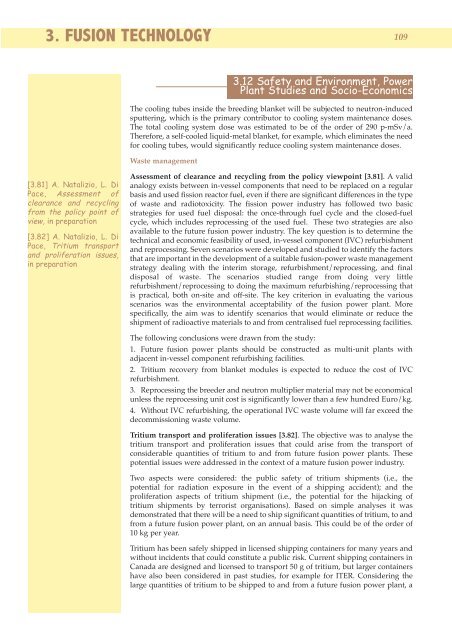1. magnetic confinement - ENEA - Fusione
1. magnetic confinement - ENEA - Fusione
1. magnetic confinement - ENEA - Fusione
You also want an ePaper? Increase the reach of your titles
YUMPU automatically turns print PDFs into web optimized ePapers that Google loves.
3. FUSION TECHNOLOGY 109<br />
The cooling tubes inside the breeding blanket will be subjected to neutron-induced<br />
sputtering, which is the primary contributor to cooling system maintenance doses.<br />
The total cooling system dose was estimated to be of the order of 290 p-mSv/a.<br />
Therefore, a self-cooled liquid-metal blanket, for example, which eliminates the need<br />
for cooling tubes, would significantly reduce cooling system maintenance doses.<br />
Waste management<br />
3.12 Safety and Environment, Power<br />
Plant Studies and Socio-Economics<br />
[3.81] A. Natalizio, L. Di<br />
Pace, Assessment of<br />
clearance and recycling<br />
from the policy point of<br />
view, in preparation<br />
[3.82] A. Natalizio, L. Di<br />
Pace, Tritium transport<br />
and proliferation issues,<br />
in preparation<br />
Assessment of clearance and recycling from the policy viewpoint [3.81]. A valid<br />
analogy exists between in-vessel components that need to be replaced on a regular<br />
basis and used fission reactor fuel, even if there are significant differences in the type<br />
of waste and radiotoxicity. The fission power industry has followed two basic<br />
strategies for used fuel disposal: the once-through fuel cycle and the closed-fuel<br />
cycle, which includes reprocessing of the used fuel. These two strategies are also<br />
available to the future fusion power industry. The key question is to determine the<br />
technical and economic feasibility of used, in-vessel component (IVC) refurbishment<br />
and reprocessing. Seven scenarios were developed and studied to identify the factors<br />
that are important in the development of a suitable fusion-power waste management<br />
strategy dealing with the interim storage, refurbishment/reprocessing, and final<br />
disposal of waste. The scenarios studied range from doing very little<br />
refurbishment/reprocessing to doing the maximum refurbishing/reprocessing that<br />
is practical, both on-site and off-site. The key criterion in evaluating the various<br />
scenarios was the environmental acceptability of the fusion power plant. More<br />
specifically, the aim was to identify scenarios that would eliminate or reduce the<br />
shipment of radioactive materials to and from centralised fuel reprocessing facilities.<br />
The following conclusions were drawn from the study:<br />
<strong>1.</strong> Future fusion power plants should be constructed as multi-unit plants with<br />
adjacent in-vessel component refurbishing facilities.<br />
2. Tritium recovery from blanket modules is expected to reduce the cost of IVC<br />
refurbishment.<br />
3. Reprocessing the breeder and neutron multiplier material may not be economical<br />
unless the reprocessing unit cost is significantly lower than a few hundred Euro/kg.<br />
4. Without IVC refurbishing, the operational IVC waste volume will far exceed the<br />
decommissioning waste volume.<br />
Tritium transport and proliferation issues [3.82]. The objective was to analyse the<br />
tritium transport and proliferation issues that could arise from the transport of<br />
considerable quantities of tritium to and from future fusion power plants. These<br />
potential issues were addressed in the context of a mature fusion power industry.<br />
Two aspects were considered: the public safety of tritium shipments (i.e., the<br />
potential for radiation exposure in the event of a shipping accident); and the<br />
proliferation aspects of tritium shipment (i.e., the potential for the hijacking of<br />
tritium shipments by terrorist organisations). Based on simple analyses it was<br />
demonstrated that there will be a need to ship significant quantities of tritium, to and<br />
from a future fusion power plant, on an annual basis. This could be of the order of<br />
10 kg per year.<br />
Tritium has been safely shipped in licensed shipping containers for many years and<br />
without incidents that could constitute a public risk. Current shipping containers in<br />
Canada are designed and licensed to transport 50 g of tritium, but larger containers<br />
have also been considered in past studies, for example for ITER. Considering the<br />
large quantities of tritium to be shipped to and from a future fusion power plant, a













